Many beginner musicians want to learn to improvise on the guitar, but just don’t know how to start. In this guest post, Greg O’Rourke from fretdojo.com teaches you three easy tricks that will supercharge your guitar scales and bring more life to your solos.
Have you ever tried to improvise on the guitar and it sounds like you’re just running scales up and down the fretboard?
Look:
Regardless of what style you want to improvise in, only knowing the scales isn’t enough.
Here’s the deal:
To sound like a convincing improviser, you need to learn the vocabulary of the style you want to play — meaning the particular patterns and approaches that give a style of music its unique sound.
Which is what this article is all about.
By the end of this post, you’re going to learn three easy jazz tricks to transform any boring old guitar scale into a hip, jazzy-sounding pattern that will supercharge your soloing.
Let’s get into it!
The Basic Idea
The approach I’m going to show you is to:
- Look at the finger patterns on each string of a guitar scale, then
- Substitute them with finger patterns commonly used in jazz.
For this lesson we’re going to use the ol’ faithful C major scale.
Let’s use the well-known pattern commonly played in the 7th position on the fretboard (for those of you who know the CAGED system, this would be the “E” pattern of C Major):
Listen & Play: Guitar Improvisation Exercise 1
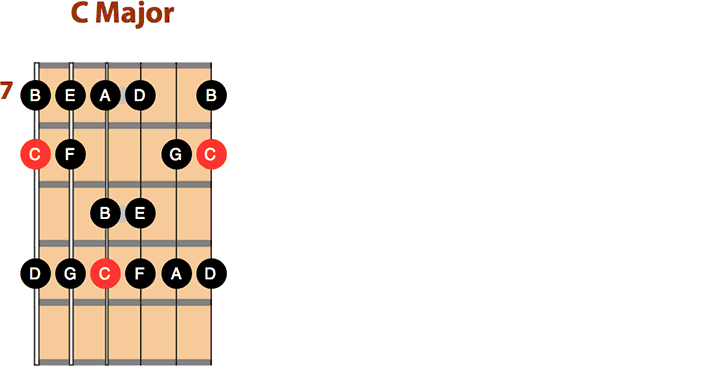
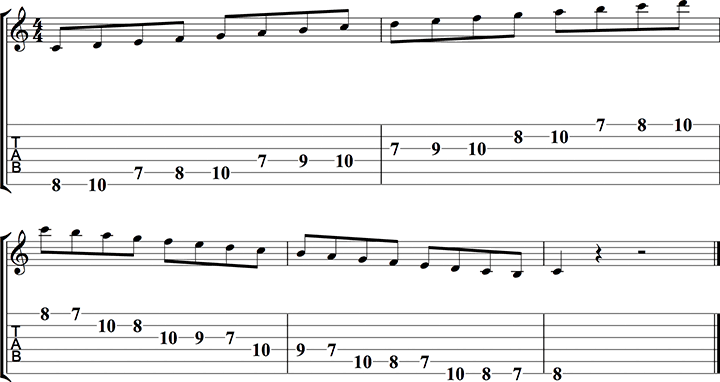
Audio:
If you aren’t familiar with this guitar scale pattern yet, practice playing bits and pieces of it over the backing track to get familiar, as the video below demonstrates:
Video Example:
Backing Track:
As you can see, if you improvise just by going up and down guitar scales it sounds like, well… just like scales going up and down.
Boring!
Let’s see what we can do to jazz this sucker up…
Step 1: Substitute the ‘134’ Pattern
Look at the notes that sit on the 3rd string for this guitar scale:
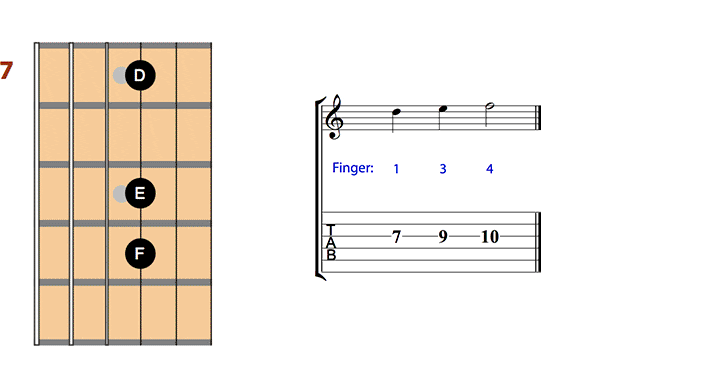
As you can see, this string uses fingers 1, 3, and 4, hence a ‘134’ pattern.
Hmmm… let’s try something.
Replace this finger pattern with a ‘4123’ pattern instead:

To get used to the idea of replacing the finger pattern, play the simple exercise below.
Listen & Play: Guitar Improvisation Exercise 2
Audio:
Here’s the trick.
Now, whenever you play the 3rd string as you improvise, replace the ‘134’ pattern with the new ‘4123’ pattern.
Video Example:
Go on — try it! Here’s the backing track once again:
Backing Track:
Hang on:
Notice how this can be used on other strings of this C major scale as well…
Eureka! The 4th string also has this ‘134’ pattern.
Do the same finger pattern replacement on this string too.
Listen & Play: Guitar Improvisation Exercise 3
Audio:
I want you to practice soloing over the backing track once again.
This time, whenever you hit the 4th string or the 3rd string, play the pattern ‘4123’.
Backing Track:
Great — you’re sounding a whole lot jazzier already!
Let’s have a look at how we can mess with the other strings to get more of that jazzy sound into our soloing.
Step 2: Substitute the ‘124’ pattern
Here’s the finger pattern on the 1st string in this C Major scale:
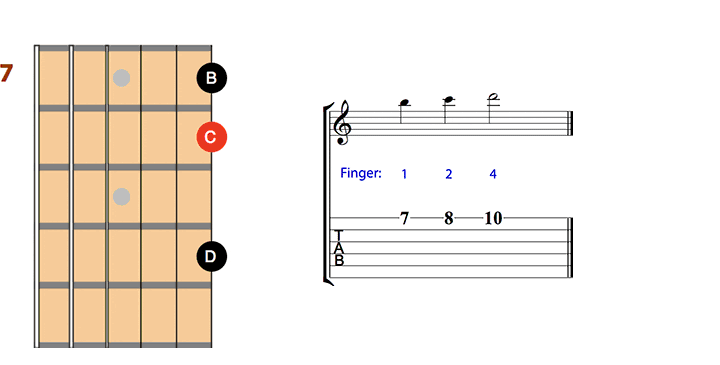
As you can see, the 1st string has a ‘124’ finger pattern.
It’s time to soup up this finger pattern too.
Can we use the ‘4123’ pattern (the one you used on the 3rd and 4th string) here?
No, you can’t — the final note (the ‘3’) will be a note that is not in C Major, which will sound bad.
For this approach to work, we need a pattern that will finish on a scale note.
So, we’ll need a different pattern. Let me think…
How about this one:

Looks good — this new ‘43241’ pattern ends up on a scale note (the ‘1’).
This ‘43241’ pattern is one of the most commonly used vocabulary ideas in jazz, and it’s easy to play too.
To get familiar with this new pattern, play this exercise on the 1st string:
Listen & Play: Guitar Improvisation Exercise 4
Audio:
Improvise with the backing track in a similar way to what you did on the 3rd and 4th string.
This time, whenever you play the 1st string replace the ‘124’ pattern with the ‘43241’ pattern.
Video Example:
While you’re at it, make it more interesting by experimenting with different rhythms and accents each time you play the pattern.
Backing Track:
This ‘43241’ pattern works really well on the 5th and 6th strings too, as they also have a ‘124’ pattern in this C Major guitar scale.
I’ll show you what I mean:
Listen & Play: Guitar Improvisation Exercise 5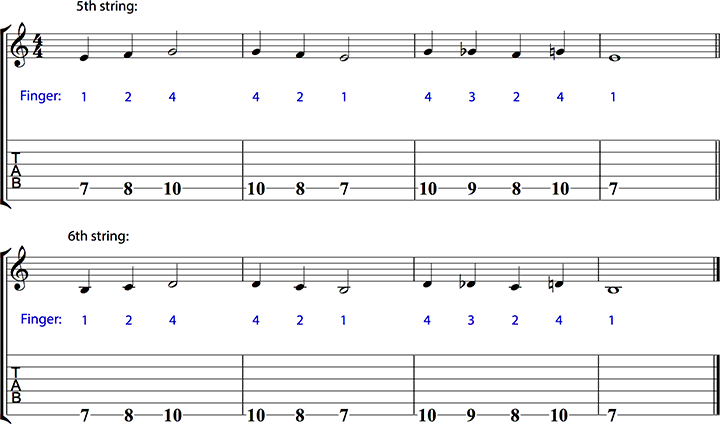
Audio:
Step 3: Enclosures
Great, so we have now jazzed up every string of this guitar scale…
Or have we?
Hang on — it looks like one string hasn’t been covered yet: the 2nd string.
The problem with the 2nd string in this C Major guitar scale pattern is that there are only two notes on the string.
D’oh! We can’t play the other two patterns you’ve learned so far, as they were for three notes, not two.
Don’t sweat! There is a solution.
We’re going to use enclosures to surround (or ‘enclose’) each of these two-note scales.
I know what you’re thinking:
“What’s an enclosure??”
I knew you were going to ask that.
Let me explain.
Enclosures are one of the most commonly used devices found in jazz solos.
They give a great chromatic sound and are characteristic of jazz bebop in particular.
Enclosures are useful as they can be added to any note in any guitar scale.
Here’s an example of an enclosure:
Listen & Play: Guitar Improvisation Exercise 6
Audio:
In this next exercise, you’re going to apply an enclosure to each of the two notes found on the 2nd string of the C Major guitar scale pattern:
Listen & Play: Guitar Improvisation Exercise 7
Audio:
Now try to improvise on the backing track with enclosures on these notes whenever you hit the 2nd string:
Video Example:
Backing Track:
Note: You can do enclosures on any note of the scale, not just these two scale notes on the second string — try it and see!
Step 4: Combining it All Together
Fantastic! We have now jazzified every string of C Major guitar scale.
Your final challenge awaits…
Have a go at playing the substituted finger pattern for each string one after the other, going from the 1st string to the 6th string:
- 1st string: 43241
- 2nd string: enclosures
- 3rd string: 4123
- 4th string: 4123
- 5th string: 43241
- 6th string: 43241
Listen & Play: Guitar Improvisation Exercise 8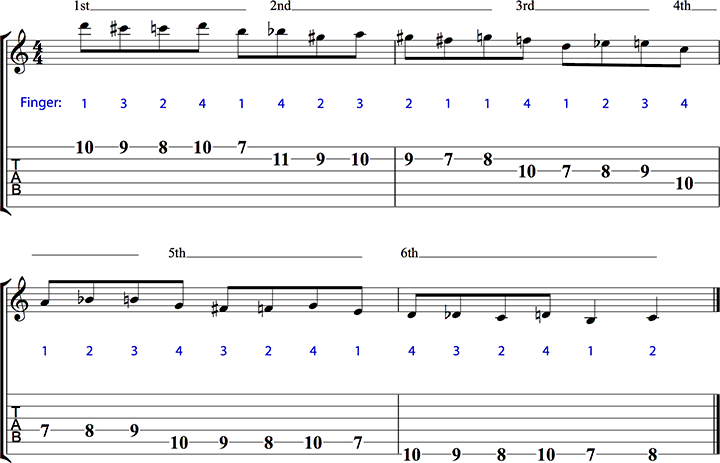
Audio:
Now improvise on the backing track by adding the relevant pattern for each string here and there as you solo.
Video Example:
Backing Track:
A couple of things to be aware of as you improvise on the guitar:
- If you do the new jazzy patterns too much, it will sound too “spicy.” Just add them here and there and it will sound totally hip.
- The challenge here is to remember what pattern goes with which string in the guitar scale. Be careful as you’ll find it won’t sound very good if you mix them up by mistake.
Huzzah! Just by adding some simple finger patterns, you know have an interesting, jazzy foundation for your guitar solos.
Summary
You can apply this technique to any guitar scale:
- Whenever you have a ‘134’ pattern on a string, replace it with ‘4123’.
- Whenever you have a ‘124’ pattern on a string, replace it with ‘43241’.
- Whenever you have only 2 notes on a string, use enclosures around each note.
So there you have it: three simple finger patterns that you can apply to any guitar scale, to instantly get that jazzy sound.
The question is…
What guitar scales do YOU have under your fingers to jazz up?
Let me help you out.
Download a free copy of my Essential Guitar Scale Patterns PDF eBook, and you’ll learn the most important guitar scale shapes that you need to know for any style of music.
I would also like to give a shout-out to Matt Warnock at mattwarnockguitar.com, whom I credit first showing me these innovative ideas for scale patterns. He’s a great teacher and has a ton of resources about jazz guitar improvisation on his site.
I wish you well in your guitar practice. Happy soloing!
Ready to learn more? Find a local or online guitar teacher, or check out our live, online group classes for guitar!
 Post Author: Greg O’Rourke
Post Author: Greg O’RourkeGreg O’Rourke is a professional Australian jazz guitarist and holds a Bachelor of Music (Hons) with the Australian National University. He’s also the owner of fretdojo.com, which offers detailed lessons and eBooks on how to master jazz guitar.
Suzy S.
